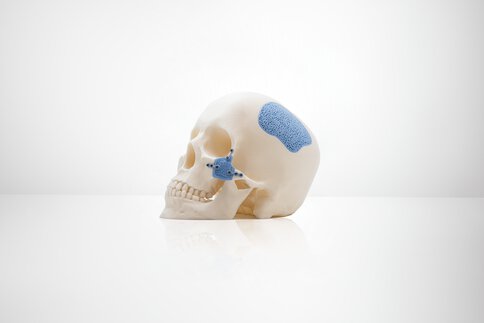High-tech ceramics for medical technology—innovation meets precision
Ceramic materials are now an integral part of modern medical technology. They offer unique advantages such as biocompatibility, wear resistance and chemical stability. In surgical instruments, ceramics ensure sharp, durable cutting edges and electrical insulation in high-frequency surgery. Medical devices benefit from ceramic components due to their temperature resistance and high reliability.
Implants made of zirconium oxide or tricalcium phosphate impress with their tissue compatibility and resilience—ideal for applications in orthopedics and dentistry.
In medical analysis, ceramic substrates and microstructures enable innovative lab-on-a-chip systems and sensor technology as well as precise dosing and conveying of liquids and gases.

Ceramics in medical technology: innovation between precision, biocompatibility and high tech
Ceramic materials have become firmly established in medical technology, not only in the form of conventional dental or hip implants but also increasingly as high-performance materials for complex surgical instruments, medical devices and precise analytical methods. Their exceptional combination of biocompatibility, wear resistance, corrosion resistance and electrical insulation makes them a key material for applications with the highest demands on safety, durability and functionality.
Implant technology uses modern bioactive ceramics such as tricalcium phosphate (TCP) and hydroxyapatite (HAP), which support the natural bone metabolism and are characterized by high resorption and integration into the tissue. Additive manufacturing processes—especially 3D printing—enable patient-specific structures with complex geometry, a porous structure and customized functionality. Zirconium oxide has proven to be a particularly fracture-resistant, esthetic and bioinert material for dental implants, while aluminum oxide-based materials have also long been used for joint implants.
In the field of surgical instruments, ceramics offer decisive advantages thanks to their electrical insulation and X-ray transparency, especially in minimally invasive surgery or image-guided interventions. Cutting tools made of oxide ceramic materials enable precise cuts while minimizing thermal damage and particle abrasion. They are resistant to aggressive disinfectants and can be sterilized—a clear advantage in everyday clinical practice.
Another growth area is laboratory diagnostics. In analytical devices and microfluidic systems, ceramic components ensure chemical stability, microscale precision and outstanding temperature resistance. The combination with glass ceramics or hybrid materials opens up new perspectives in point-of-care analysis and molecular diagnostics.
A look into the future reveals further potential: Functionalized ceramic surfaces with antimicrobial or bioactive properties are increasingly being researched, as are sensor-integrated ceramics, for example, for the wireless acquisition of physiological parameters directly in the body. New application horizons are also being opened up in the combination of ceramics with electronics, for example, in implantable stimulation systems.
Ceramics in medical technology thus represent a symbiosis of material innovation, precision technology and growing clinical demand. Anyone following developments in this dynamic field will gain exciting insights into the material systems of tomorrow.
Your direct way to ceramitec 2026!
All it takes is a few clicks to go online and purchase your personal ticket to ceramitec or directly redeem your voucher.
